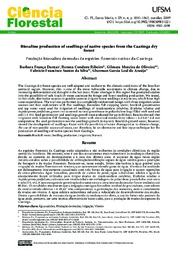Biosaline production of seedlings of native species from the Caatinga dry forest.
Biosaline production of seedlings of native species from the Caatinga dry forest.
Author(s): DANTAS, B. F.; RIBEIRO, R. C.; OLIVEIRA, D. M. de; SILVA, F. F. S. da; ARAUJO, G. G. L. de
Summary: The Caatinga dry forest species are well adapted and resilient to the climatic conditions of the Brazilian semiarid region. However, this is one of the more vulnerable ecosystems to climate change, due to increasing deforestation and drought in the last years. Water shortage in this region has prompted studies into the possibility of safe brackish water use/reuse for forage and forest seedling production. We tested, in this study, alternative sources to potable water to irrigate forest seedlings in nurseries, which have high water expenditure. The trail was performed in a completely randomized design with three irrigation water sources and four replications with five seedlings. Biosaline fish cropping water; brackish groundwater and tap water were used for irrigation of seedlings of Anadenanthera colubrina, Erythrina velutina and Aspidosperma pyrifolium, grown in a screened nursery greenhouse in polyethylene bags filled with sand and soil (1:1 v/v). Seed germination and seedlings growth were evaluated for up to 80 days. Results showed that irrigation with biosaline fish farming waste water with electrical conductivity values > 6 dS.m-1 did not compromise the seed germination nor the seedlings growth in nursery. Brackish ground water, however, slowed the development of seedlings. Faced with the possibility of water shortages due to climate change, the use of non-potable sources of water, can therefore, be an alternative and low input technique for the production of seedlings of native species from Caatinga.
Publication year: 2019
Types of publication: Journal article
Unit: Embrapa Semi-arid Region
Observation
Some of Embrapa's publications are published as ePub files. To read them, use or download one of the following free software options to your computer or mobile device. Android: Google Play Books; IOS: iBooks; Windows and Linux: Calibre.
Access other publications
Access the Agricultural Research Database (BDPA) to consult Embrapa's full library collection and records.
Visit Embrapa Bookstore to purchase books and other publications sold by Embrapa.

